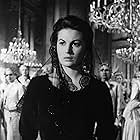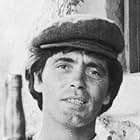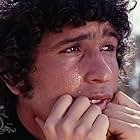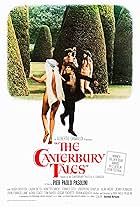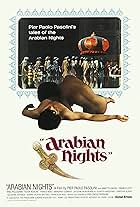Rescued from abandonment and raised by the King and Queen, Oedipus is still haunted by a prophecy--he'll murder his father and marry his mother.Rescued from abandonment and raised by the King and Queen, Oedipus is still haunted by a prophecy--he'll murder his father and marry his mother.Rescued from abandonment and raised by the King and Queen, Oedipus is still haunted by a prophecy--he'll murder his father and marry his mother.
- Awards
- 4 wins & 4 nominations
Giovanni Ivan Scratuglia
- Sacerdote
- (as Ivan Scratuglia)
Laura Betti
- Jocasta's Maid
- (uncredited)
Pier Paolo Pasolini
- High Priest
- (uncredited)
Isabel Ruth
- Jocasta's Maid with a Lamb
- (uncredited)
- Director
- Writers
- All cast & crew
- Production, box office & more at IMDbPro
Storyline
Did you know
- TriviaFirst part of Pier Paolo Pasolini's "Mythical Cycle" also including Teorema (1968), Pigsty (1969) and Medea (1969).
- ConnectionsEdited into Days of Nietzsche in Turin (2001)
Featured review
This tale of Oedipus starts off and ends in the twentieth century, though for the most part is set in a primitive version of ancient Greece. There is not much rational connection between the stories, but Pasolini manages to forge himself a free pass on that one. Whilst the Oedipus Complex theme of the first story is meant to be taken quite literally, and is basically autobiographical, the middle story, recognisably Sophoclean, is more, in my opinion, meant to be about an angry confused man who cannot stomach his fate nor confront truths about his identity. As both sections do genuinely feel autobiographical they knit together just fine.
The first section of the film set in the 1920s is the best piece of filming I have seen from Pasolini and made me really excited. There's a wide open scene of children running off around a playing field on a hot piercing day, one of those thick childhood days when the emotions battened down the hatches on squire intellect. I was reminded very much of an Edith Sitwell poem (Green Flows the River of Lethe - O):
"I stood near the Cities of the Plains / And the young girls were chasing their hearts like the gay butterflies / Over the fields of summer - / O evanescent velvets fluttering your wings / Like winds and butterflies on the Road from Nothing to Nowhere!"
The sentiment all the more surprisingly apt given that the second part of the film is shot in what could be the ruins of Sodom and Gomorrah (the Cities of the Plains) for all we know.
The rage of Oedipus, which occurs frequently in the movie could be liked to another part of the poem:
"But in the summer drought / I fled, for I was a Pillar of Fire, I was destruction / Unquenched, incarnate and incarnadine // I was Annihilation / Yet white as the Dead Sea, white as the Cities of the Plains / For I listened to the noontide and my veins / That threatened thunder and the heart of roses."
Part of Pasolini's drive for shooting the films seems to be to continue his fascination with ancient buildings and ruins which he demonstrated three years earlier in his superb 1964 documentary The Walls of Sana'a for which he travelled to Yemen.
The end of the playing field scene features Jocasta suckling Oedipus. She gazes directly at the camera and thus the audience for a long period, in which she goes through a range of emotions, including what could be arousal, followed by disquiet, which ultimately turns into a distanced understanding. For me this is cinematically equivalent to the Mona Lisa, which is also a gay man's meditation on his mother, greatly cryptic yet provocative, set in against a natural backdrop.
Silvana Mangano, who plays the mother in both parts of the movie (and would star in Pasolini's Teorema the following year), carries a lot of it. Her beauty, her alabaster skin and wispy eyebrows, her perfectly tangled plaits (which would send Fuseli to his knees), are commanding. She has an artistic skill that eclipses that of Franco Citti (Oedipus) and Ninetto Davoli (Thebes' crier) quite totally. Franco Citti's lack of skill, whilst occasionally infuriating in the context of the story (his is not the demeanour of a king) do however lend the film a level of authenticity, given the primary motive of this sequence, which was to demonstrate a pained adolescent fury and denial, which was ignorant at its base.
There's an unusual device of writing characters' thoughts in black lettering on a white background, which doesn't quite work but which would be far better than the presumable alternative of camera-faced soliloquies.
Some of the locations in the movie felt truly dream-like to me, for instance the unkempt walled piazza-garden of Jocasta, the crumbled ruin where Oedipus meets a naked adolescent girl on his peregrinations, the mountainous areas between cities.
The props in the movie are cheap and fantastical but quite brilliant, the wind-blown hands on the milestones to Thebes, the quite bizarre head gear of the Pythoness, the soldiers, and King Laius. Modern producers who delight in throwing money at movies, please note how Pasolini achieves far better results with great economy.
Cultural references abound, my favourite being the Japanese music, which doesn't seem to have been referenced anywhere (there are no closing credits in the movie), but sounded very much like the Toru Takemitsu scores of Ansatsu (Assasination), Woman in the Dunes, and Harakiri.
The story in a strict narrative sense has problems, Citti doesn't convince as any type of king or warrior, giving the appearance of not understanding his lines at some points, and the suicide of Jocasta makes no sense in the wake of her discussions with her son. It is a movie where feeling rather than thinking brings greater rewards.
The first section of the film set in the 1920s is the best piece of filming I have seen from Pasolini and made me really excited. There's a wide open scene of children running off around a playing field on a hot piercing day, one of those thick childhood days when the emotions battened down the hatches on squire intellect. I was reminded very much of an Edith Sitwell poem (Green Flows the River of Lethe - O):
"I stood near the Cities of the Plains / And the young girls were chasing their hearts like the gay butterflies / Over the fields of summer - / O evanescent velvets fluttering your wings / Like winds and butterflies on the Road from Nothing to Nowhere!"
The sentiment all the more surprisingly apt given that the second part of the film is shot in what could be the ruins of Sodom and Gomorrah (the Cities of the Plains) for all we know.
The rage of Oedipus, which occurs frequently in the movie could be liked to another part of the poem:
"But in the summer drought / I fled, for I was a Pillar of Fire, I was destruction / Unquenched, incarnate and incarnadine // I was Annihilation / Yet white as the Dead Sea, white as the Cities of the Plains / For I listened to the noontide and my veins / That threatened thunder and the heart of roses."
Part of Pasolini's drive for shooting the films seems to be to continue his fascination with ancient buildings and ruins which he demonstrated three years earlier in his superb 1964 documentary The Walls of Sana'a for which he travelled to Yemen.
The end of the playing field scene features Jocasta suckling Oedipus. She gazes directly at the camera and thus the audience for a long period, in which she goes through a range of emotions, including what could be arousal, followed by disquiet, which ultimately turns into a distanced understanding. For me this is cinematically equivalent to the Mona Lisa, which is also a gay man's meditation on his mother, greatly cryptic yet provocative, set in against a natural backdrop.
Silvana Mangano, who plays the mother in both parts of the movie (and would star in Pasolini's Teorema the following year), carries a lot of it. Her beauty, her alabaster skin and wispy eyebrows, her perfectly tangled plaits (which would send Fuseli to his knees), are commanding. She has an artistic skill that eclipses that of Franco Citti (Oedipus) and Ninetto Davoli (Thebes' crier) quite totally. Franco Citti's lack of skill, whilst occasionally infuriating in the context of the story (his is not the demeanour of a king) do however lend the film a level of authenticity, given the primary motive of this sequence, which was to demonstrate a pained adolescent fury and denial, which was ignorant at its base.
There's an unusual device of writing characters' thoughts in black lettering on a white background, which doesn't quite work but which would be far better than the presumable alternative of camera-faced soliloquies.
Some of the locations in the movie felt truly dream-like to me, for instance the unkempt walled piazza-garden of Jocasta, the crumbled ruin where Oedipus meets a naked adolescent girl on his peregrinations, the mountainous areas between cities.
The props in the movie are cheap and fantastical but quite brilliant, the wind-blown hands on the milestones to Thebes, the quite bizarre head gear of the Pythoness, the soldiers, and King Laius. Modern producers who delight in throwing money at movies, please note how Pasolini achieves far better results with great economy.
Cultural references abound, my favourite being the Japanese music, which doesn't seem to have been referenced anywhere (there are no closing credits in the movie), but sounded very much like the Toru Takemitsu scores of Ansatsu (Assasination), Woman in the Dunes, and Harakiri.
The story in a strict narrative sense has problems, Citti doesn't convince as any type of king or warrior, giving the appearance of not understanding his lines at some points, and the suicide of Jocasta makes no sense in the wake of her discussions with her son. It is a movie where feeling rather than thinking brings greater rewards.
- oOgiandujaOo_and_Eddy_Merckx
- Jan 1, 2011
- Permalink
- How long is Oedipus Rex?Powered by Alexa
Details
Box office
- Gross worldwide
- $2,364
- Runtime1 hour 44 minutes
- Aspect ratio
- 1.85 : 1
Contribute to this page
Suggest an edit or add missing content












